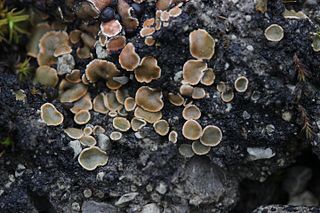
Psora is a genus of lichen-forming fungi in the family Psoraceae. Members of the genus are commonly called fishscale lichens. Lichens in the genus Psora generally have a squamulose thallus and anthraquinones in the hymenium. Photobiont partners of Psora lichens include members of the green algal genera Asterochloris, Chloroidium, Myrmecia, and Trebouxia.
Aciculopsora is a genus of lichens in the family Ramalinaceae. It was circumscribed by lichenologists André Aptroot and Marie Trest in 2006.
Crustospathula is a genus of five species of crustose lichens in the family Malmideaceae. They are characterized by their stalked and sometimes branched cartilaginous soredia and Bacidia-like apothecia.
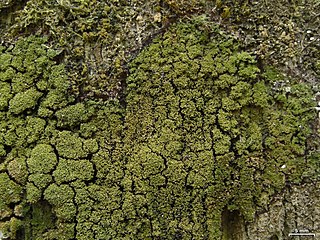
Phyllopsora is a genus of lichen-forming fungi in the family Ramalinaceae. It was circumscribed by Swiss botanist Johannes Müller Argoviensis in 1894, with Phyllopsora breviuscula assigned as the type species.
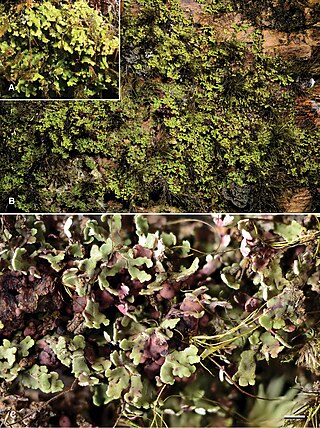
Krogia is a genus of corticolous lichens in the family Ramalinaceae. It occurs in tropical humid forests and rainforests. The genus was circumscribed by Norwegian lichenologist Einar Timdal in 2002, with Krogia coralloides assigned as the type species.

Toniniopsis is a genus of crustose and squamulose lichens in the family Ramalinaceae. The genus was circumscribed by Swiss lichenologist Eduard Frey in 1926, with Toniniopsis obscura designated the type and only species. The genus name of Toniniopsis is in honour of Carlo Tonini (1803–1877), who was an Italian chemist and botanist (Lichenology), who worked in Verona and was a member and President of the Academy of Agriculture. As a result of molecular phylogenetic studies, several species, formerly classified in genus Bacidia, have been transferred to Toniniopsis.
Hildur Krog was a Norwegian botanist.
Bibbya is a genus of fruticose lichens in the family Ramalinaceae.
Peltigera wulingensis is a species of terricolous (ground-dwelling), foliose lichen in the family Peltigeraceae. Originally described from specimens found in northern China, it has since been recorded in Canada, Norway, and Russia.

Psora taurensis is a species of terricolous (ground-dwelling), squamulose lichen in the family Lecanoraceae. It is found in the Taurus Mountains of Turkey.
Biatora oxneri is a species of corticolous (bark-dwelling) lichen in the family Ramalinaceae. It is found in the Russian Far East and in South Korea.
Krogia microphylla is a rare species of corticolous (bark-dwelling), squamulose (scaley) lichen in the family Ramalinaceae. Found in the Dominican Republic, it was formally described as a new species in 2011 by lichenologist Einar Timdal. The type specimen was collected from a cloud forest in El Seibo Province at an altitude of about 450 m (1,480 ft). It is only known from the type collection. The species epithet refers to the tiny squamules that make up the thallus.
Phyllopsora amazonica is a species of corticolous (bark-dwelling), crustose lichen in the family Ramalinaceae. It is found in the Amazon rainforest of Brazil.
Phyllopsora concinna is a species of corticolous (bark-dwelling), squamulose (scaley) lichen in the family Ramalinaceae. Found in Central and South America, it was formally described as a new species in 2019 by lichenologists Sonja Kistenich and Einar Timdal. The lichen has a scaley, effuse (spread-out) thallus that is pale green with a well-developed, white prothallus. Apothecia occur rarely; they are brownish with a paler margin, measuring up to 1 mm in diameter. Ascospores are simple with a narrow ellipsoid to fusiform shape, and dimensions of 12.5–16·0 by 3.5–4.0 μm. Atranorin and parvifoliellin are major lichen products that occur in this species. The latter compound distinguishes it chemically from the morphologically similar species Phyllopsora cinchonarum, which instead contains lobaric acid. The botanical name concinna, refers to its "beautiful" appearance.
Phyllopsora neotinica is a species of corticolous (bark-dwelling), squamulose (scaley) lichen in the family Ramalinaceae. Found in North, Central, and South America, it was formally described as a new species in 2019 by lichenologists Sonja Kistenich and Einar Timdal. It is similar to Phyllopsora chodatinica, but unlike that species, it contains argopsin and often zeorin, but it lacks chodatin. The species epithet neotinica is a contraction of "neotropical" and Phyllopsora chodatinica.
Crustospathula amazonica is a species of corticolous (bark-dwelling), crustose lichen in the family Ramalinaceae. Found in South America, it was formally described as a new species in 2014 by lichenologists André Aptroot, Marcela Cáceres, and Einar Timdal. The type specimen was collected by the first two authors from the Parque Natural Municipal de Porto Velho, where it was found growing on the smooth bark of a tree in a primary rainforest. It also occurs in French Guiana and Peru, and tends to grow in association with lichens of the genus Porina and with thelotremoid members of the family Graphidaceae. The lichen has a film-like, green thallus consisting of fine, aggregated granules; no prothallus is present. Soredia are whitish, roughly spherical, and occur at the tips of cartilaginous stalks up to 3 mm tall.
Physcidia striata is a species of corticolous (bark-dwelling), microfoliose lichen in the family Ramalinaceae. Found in South America, it was formally described as a new species in 2014 by lichenologists André Aptroot, Marcela Cáceres, and Einar Timdal. The type specimen was collected by the first two authors from the Estação Ecológica de Cuniã (Rondônia), where it was found growing on the smooth bark of a tree in a primary rainforest. It also occurs in Peru. The thallus of the lichen is a loose mat of squamules (scales) without a hypothallus. Its lobes are smooth, flat, branched, and greyish-green, measuring 2–7 mm long by 0.5–1.5 mm wide. The species epithet striata refers to the faint longitudinal striations that are present on the lobe undersides. Isidia occur on the thallus surface; they are the same colour as the thallus, with dimensions of 0.3–0.7 mm long by 0.1–0.2 mm wide. When they are abraded, it reveals the whitish colour of the underlying medulla. The lichen contains divaricatic acid, a lichen product that is revealed with the use of thin-layer chromatography.
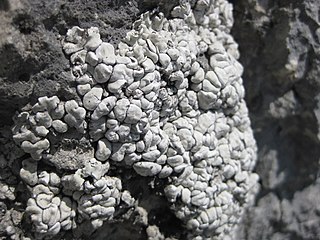
Thalloidima is a genus of lichen-forming fungi in the family Ramalinaceae. It has 13 species.
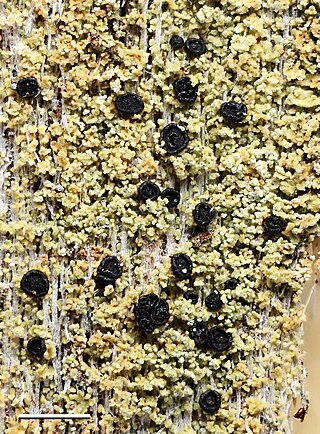
Xylopsora canopeorum is a squamulose (scaly), corticolous (bark-dwelling) lichen species in the family Umbilicariaceae. Discovered in the canopies of Sequoia sempervirens in California, United States, it was formally described as new to science in 2018. It is endemic to the central coastal region of California, living within the unique ecosystems of Big Basin Redwoods State Park and Armstrong Redwoods State Natural Reserve, areas known for their ancient coast redwood forests. The lichen evolves from a crust-like to scale-like form, developing into coral-like crusts as it matures, complemented by distinctive flat, black reproductive discs. This species has varying greyish-green to medium brown coloration and occasionally forms soralia, which release powdery reproductive propagules called soredia. Xylopsora canopeorum is distinguished from closely related species by its smaller, partly coral-like squamules (scales), the occurrence of soralia on its surface, and in some specimens, the presence of both thamnolic and friesiic acids within the thallus.
Knightiellastrum is a single-species fungal genus in the family Icmadophilaceae. This monotypic genus the contains the corticolous (bark-dwelling), squamulose lichen species Knightiellastrum eucalypti, found in Tasmania, Australia.







